Introducing the FreeBuds 5i, Huawei faces the daunting task of surpassing the exceptional quality-to-price ratio set by their predecessors, the FreeBuds 4i, in 2022. Huawei has aimed to enhance the recipe while keeping the cost budget-friendly.
Presentation
Arriving more than six months after their initial release in China, the FreeBuds 5i have finally made their way to international markets. Their mission is clear: replace the highly regarded FreeBuds 4i. The FreeBuds 4i gained recognition for being truly wireless earbuds that offered unbeatable value for money. They were praised for their comfort and impressive sound quality with clear, detailed, and dynamic audio reproduction.
For this new iteration, Huawei promises several improvements, including better active noise reduction performance and enhanced acoustics, thanks to new speakers and support for the LDAC codec.
Price & Availability The FreeBuds 5i became available on January 16, 2023, with a price tag of €99.
TECHNICAL SHEET / CHARACTERISTICS
| Earpiece | Semi-in-ear |
| Weight | 4.9 g |
| Cable length | 0.2m |
| Removable battery | No |
| Active noise reduction | Yes |
| Listening to the environment | Yes |
| Handsfree | Yes |
| Connections | USB-C |
| Wireless connection | Bluetooth |
| Supported Bluetooth codecs | SBC, AAC, LDAC |
| Multipoint Bluetooth | Yes |
| Qi wireless charging | No |
| Waterproof rating | IP54 |
| Measured autonomy (with RBA) | 5.2 hrs |
| Measured autonomy (without RBA) | 7.5 hrs |
| Bluetooth latency measured | 140ms |
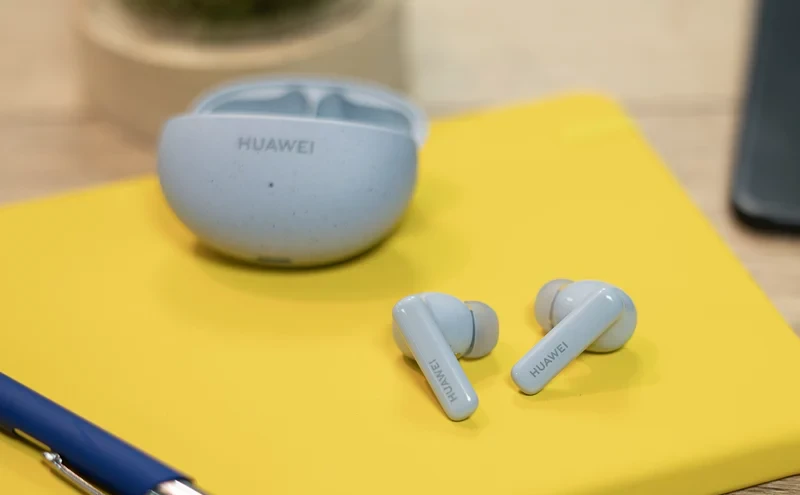
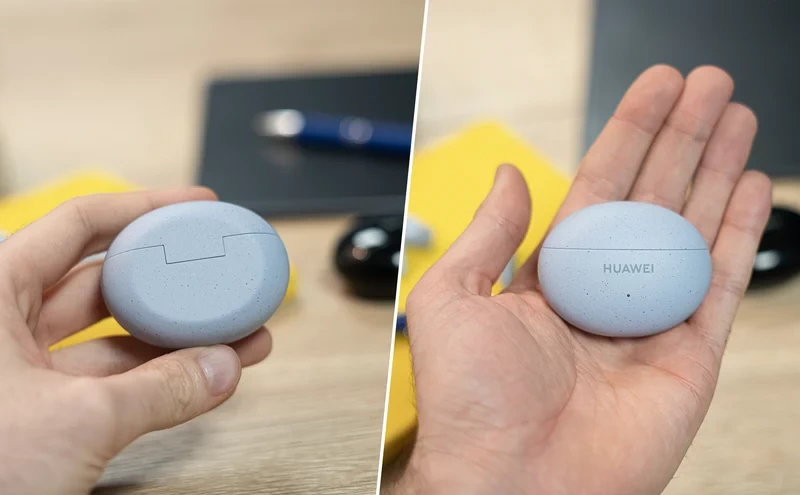
Construction & Comfort
Earbuds The FreeBuds 5i retain a design closely resembling that of the FreeBuds 4i. They feature a stem extending toward the user’s mouth and a semi-in-ear format with silicone tips. However, the FreeBuds 5i have undergone some slimming down compared to their predecessors. They are lighter, with a reduced stem length of 7 mm and a more contoured head to better fit the ear’s hollow. The build quality matches that of the FreeBuds 4i, with glossy plastic casing that tends to collect fingerprints. While the assembly marks aren’t the most discreet, the overall build appears sturdy. Additionally, these earbuds hold an IP54 certification, indicating resistance to water splashes, sweat, and dust.
In terms of comfort, the FreeBuds 5i, like the FreeBuds 4i, excel. They snugly fit into the ear’s hollow without causing discomfort or pressure points. However, comfort preferences can vary from person to person, but in our testing, the feedback was overwhelmingly positive. The secure fit also makes them suitable for occasional sports use.
Charging Case The FreeBuds 5i’s charging case closely resembles that of the FreeBuds 4i in terms of size, making it easily pocketable and operable with one hand. Huawei opted for a matte finish over the previous glossy one, which is more pleasant to touch and easier on the eyes. The new speckled color options also give it a more appealing appearance. One minor criticism is the slight play in the hinge of the case, although it’s not a major concern. On the front, there’s an indicator light, and underneath is a USB-C port for charging. Unfortunately, the case does not support wireless charging.
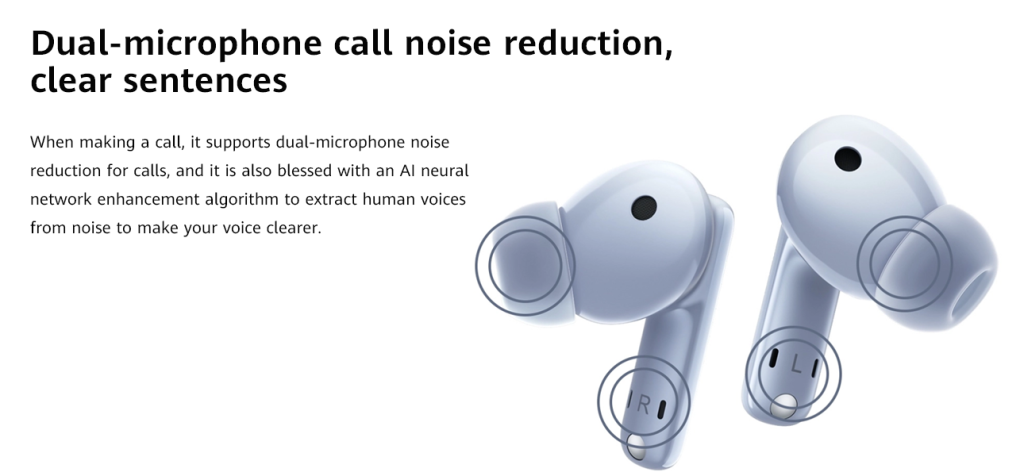
Connectivity
Pairing the FreeBuds 5i is straightforward: just press the button on the case’s exterior to initiate the process. These earbuds communicate via Bluetooth 5.2 and support SBC, AAC, and LDAC codecs. However, we encountered issues with LDAC support on both our typical test smartphone (Google Pixel 4a) and Huawei devices. To compensate, the FreeBuds 5i feature multipoint functionality, allowing simultaneous pairing with up to two sources.
In standard Bluetooth communication, there is a default latency of 243 ms, which can lead to an audio-video mismatch in videos. However, Bluetooth integration helps mitigate this latency to make it less noticeable. Playing video games, though, remains challenging, and activating the “Low latency” mode reduces latency to around 140 ms. Unfortunately, this mode can lead to connection instability, causing occasional dropouts (approximately every 7-8 minutes).
Controls
The FreeBuds 5i feature touch-sensitive surfaces on the back of each earbud for control. While responsive, the touch surfaces can be challenging to reach with fingertips, leading to occasional misfires. These earbuds take it a step further than the FreeBuds 4i by supporting sliding gestures along the stem. This allows users to manage calls, playback, track navigation, listening modes, and volume adjustments with ease.


Application
All settings and features can be managed through the Huawei AI Life app, available on both iOS and Android. The app is user-friendly, stable, and offers options for adjusting listening modes, customizing touch controls, and checking the remaining battery levels for each earbud and the case. A more comprehensive equalizer would have been a welcome addition.
Audio
Despite modifications to the acoustic architecture, the FreeBuds 5i deliver an audio experience very much in line with their predecessors, the FreeBuds 4i. This continuity is not necessarily a drawback, as the FreeBuds 4i were already known for their impressive performance.
One notable difference is the handling of high frequencies. The FreeBuds 5i exhibit greater restraint in reproducing treble, resulting in a softer, though somewhat muffled, sound. Certain instruments like cymbals, brass, and shakers lose some definition, and the soundstage feels somewhat more forward. However, this reduction in high frequencies helps mitigate the occasionally harsh sound that the FreeBuds 4i could produce due to imprecise treble.
The reduction in treble elevates the prominence of high-mids, which is not problematic as precision in this range remains commendable. The mids are well-handled, and timbre accuracy is maintained.
Similar to the FreeBuds 4i, the FreeBuds 5i excel in the bass department. There is a clear emphasis on low frequencies, but it’s well-controlled and responsive, preventing any excessive bass bleeding into other frequencies. Kicks and bass drum hits maintain impact and enjoy a solid foundation without overpowering other elements.
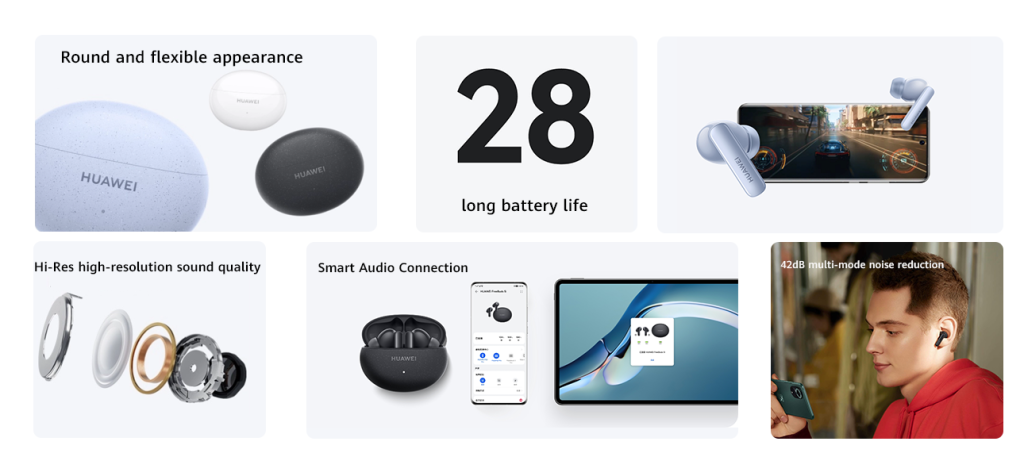
Noise Reduction
Huawei claims that the FreeBuds 5i’s active noise reduction can achieve an attenuation of around 42 dB SPL. However, real-world performance falls short, barely reaching 20 dB SPL of attenuation at maximum, even in the “Ultra” mode, the most potent setting. The FreeBuds 5i offer a different noise reduction experience compared to the FreeBuds 4i. Notably, they provide limited attenuation of extreme bass frequencies, allowing significant noise like train rumblings or engine roars to remain audible. Nevertheless, they perform admirably in reducing lower frequencies and low mids, effectively blocking out traffic and ventilation noise. However, they struggle with mid and high-frequency noise (e.g., human voices, clicking), where passive isolation is more effective.
Awareness Mode
The FreeBuds 5i’s awareness mode is somewhat lacking. This mode emphasizes mid-range frequencies, particularly human voices, but everything sounds somewhat muted due to the reduced treble and bass frequencies. Engaging in a conversation while wearing these earbuds can be challenging.
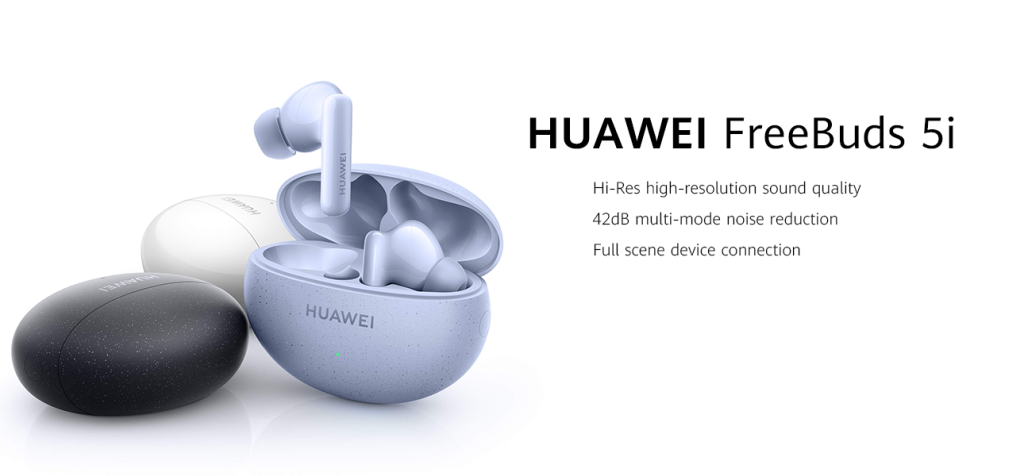
Hands-Free Calls
Similar to the FreeBuds 4i, the FreeBuds 5i do not excel in call quality. In quiet environments, voices are intelligible but suffer from a narrow bandwidth, giving them a confined quality. Precision, especially with sibilant sounds ([f] and [ʃ]), leaves room for improvement. The situation deteriorates in noisy outdoor settings, where the microphones struggle to isolate the voice from surrounding noise. This can compromise voice clarity and understanding for the person on the other end of the call.
Battery Life
Without noise reduction activated, the FreeBuds 5i deliver on their promise with 7 hours and 30 minutes of battery life, slightly above average. However, enabling noise reduction significantly reduces the battery life to approximately 5 hours and 10 minutes, about an hour less than the initially claimed 6 hours. The charging case provides approximately three additional charges.
Product information
| Product Dimensions | 0.94 x 0.85 x 1.22 inches |
|---|---|
| Item Weight | 1.55 ounces |
| ASIN | B0B4DKVDCR |
| Item model number | 55036653 |
| Batteries | 1 Lithium Polymer batteries required. (included) |
Sound Profile:
The FreeBuds 5i offer a sound profile that can be characterized as follows:
- Bass Emphasis: These earbuds place a noticeable emphasis on the bass frequencies. The low-end response is robust, providing a solid foundation for music genres that rely on deep and powerful bass, such as hip-hop, electronic, and pop. This emphasis on bass ensures that kicks and bass drums have impact and presence.
- Tamed High Frequencies: One distinct feature of the FreeBuds 5i compared to their predecessors (FreeBuds 4i) is their approach to high frequencies (treble). These earbuds exhibit a more restrained treble response. High-frequency sounds, like cymbals, brass instruments, and shakers, may lack some of the sharpness and definition found in headphones or earbuds with a more pronounced treble. This softening of the high frequencies helps mitigate any potential harshness or sibilance in the sound, making the listening experience smoother and less fatiguing.
- Clear Mid-Range: The FreeBuds 5i maintain clarity and precision in the mid-range frequencies. Human voices and instruments in this range are well-represented, ensuring that vocals sound natural and distinct. The mid-range performance contributes to good timbre accuracy and allows vocals to stand out effectively.
Sound Tests: To evaluate the sound quality of the FreeBuds 5i, various sound tests can be conducted:
- Frequency Response Test: A frequency response test can measure how accurately the earbuds reproduce different frequencies across the audible spectrum. It can reveal any deviations from a flat response and provide insights into how well the bass, mid-range, and treble frequencies are represented.
- Instrument Separation Test: This test involves playing complex musical tracks with multiple instruments to assess how well the earbuds distinguish between various sound sources. It helps evaluate the earbuds’ ability to create a clear and detailed soundstage.
- Bass Impact Test: To assess the earbuds’ bass performance, tracks with deep bass lines and bass drops can be used. This test evaluates how impactful and controlled the bass response is, without causing distortion or overwhelming other frequencies.
- Vocal Clarity Test: Vocal-centric tracks are ideal for assessing the earbuds’ ability to reproduce human voices with clarity and accuracy. It can help determine if vocals are prominent and easily distinguishable from other elements in the music.
- Dynamic Range Test: This test involves playing tracks with varying levels of loudness to evaluate the earbuds’ dynamic range. A good dynamic range allows for subtle details and nuances in music to be heard clearly.
- Soundstage Test: Soundstage refers to the perceived spatial dimension of sound. Testing soundstage involves listening to tracks that create a sense of depth and space in the audio, such as live recordings or orchestral music.
- Treble Detail Test: To assess the earbuds’ ability to reproduce treble frequencies with detail, tracks with intricate high-frequency elements, like acoustic guitar or intricate percussion, can be used.
It’s important to note that individual preferences in sound quality can vary, and what may sound excellent to one person might not be the same for another. Sound quality evaluation should consider factors such as personal music preferences and intended use (e.g., casual listening, workout sessions, or critical listening). Therefore, subjective listening tests by users with various music genres and preferences can provide valuable insights into how well the FreeBuds 5i perform in real-world scenarios.
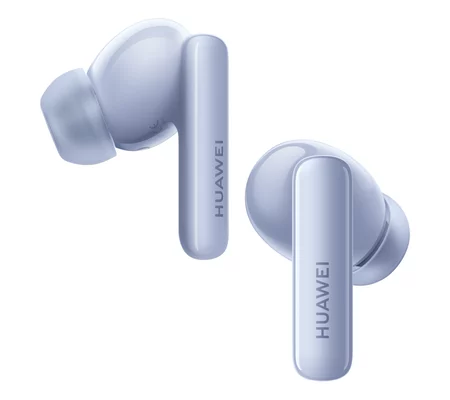
Conclusion
Following the success of the FreeBuds 4i, Huawei faced the challenge of delivering worthy successors with the FreeBuds 5i. These earbuds rise to the occasion by delivering strong sound performance and maintaining the comfort levels of their predecessors. While there are some frustrations regarding the lack of improvement in noise reduction, call quality, and battery life, the FreeBuds 5i still stand out as excellent affordable true wireless earbuds that are sure to satisfy their buyers.
STRONG POINTS
- Relatively precise and dynamic sound reproduction.
- Clean and responsive bass.
- Excellent feelings of comfort.
- Clear and stable app on iOS and Android.
- Good level of manufacturing.
WEAK POINTS
- Treble recessed and lacking definition.
- Disappointing noise reduction.
- Poor hands-free kit.
- Some stability concerns with “Low latency” mode activated.






